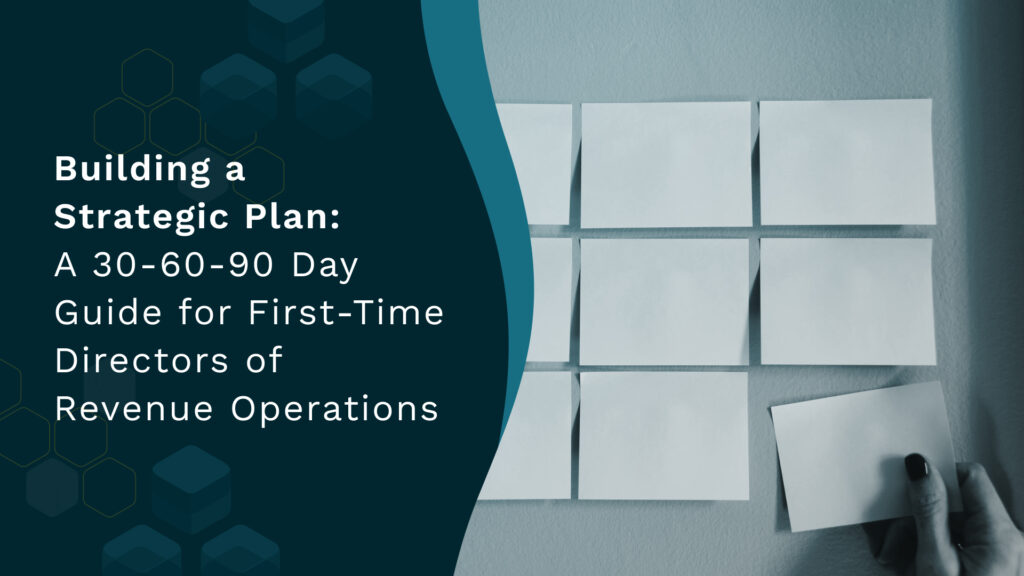
How to Harness AI to Seal Sales Pipeline Leaks
Discover how AI can boost sales by sealing pipeline leaks. Dive into Nektar's insights to accelerate your revenue and optimize your sales strategy.
Our business landscape is getting more complex by the day. Simultaneously, the sales funnel is losing its old-world charm (it’s more than 100 years old!)
It’s not about the top, middle, and bottom of the funnel anymore. As your company grows in a changing environment, finding sales pipeline leaks is inevitable.
The traditional sales funnel needs a revamp to plug these leaks. This blog dives into how the funnel has evolved. It also explores how customer retention can restore your sales pipeline’s solidity.
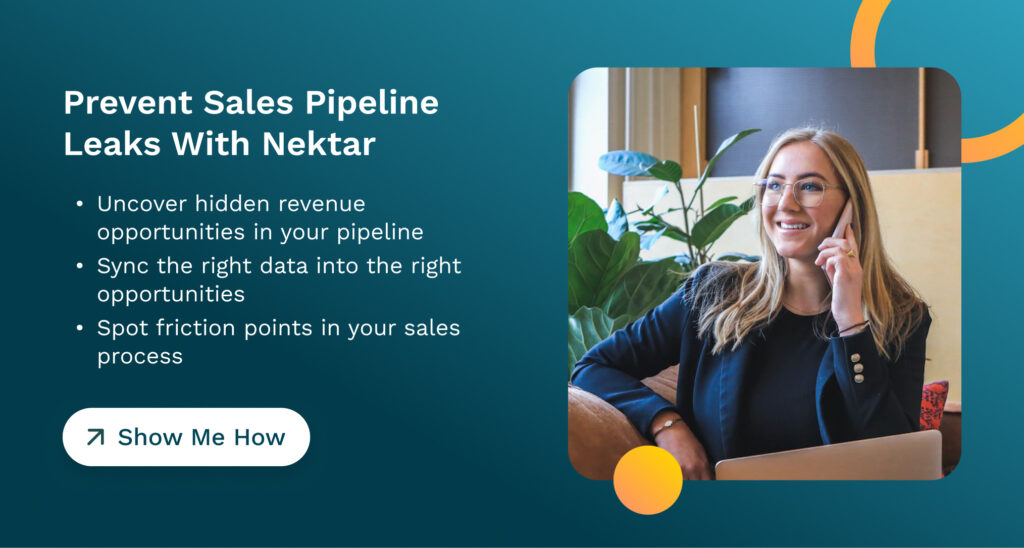
The New Funnel Is Not Exactly A…Funnel
The old funnel ends at deal closure and doesn’t account for any sales pipeline leaks afterward.
Modern organizations give equal, if not more, importance to retaining customers. Recurring revenue is a critical business goal. Therefore, the traditional cone-shaped funnel is insufficient for fixing sales pipeline leaks.

Even though 44% of organizations prioritize customer acquisition, only a meager 16% focus on retention. But when it comes to existing customers, loyal ones spend 67% more, on average, than new customers. As a result, customer retention and expansion have become top priorities in 2023 and beyond.
Consequently, the bow-tie funnel replaced the cone-shaped funnel. It’s an extension of the old one. The second half focuses solely on customer retention and expansion.
Some businesses also follow the flywheel and loop models. They believe existing customers re-enter the journey. This happens when testing a new product or renewing their contract.
At their core, the models maintain a maniacal focus on customer experience from start to end. It informs their next decision journey and you must pay attention to it.
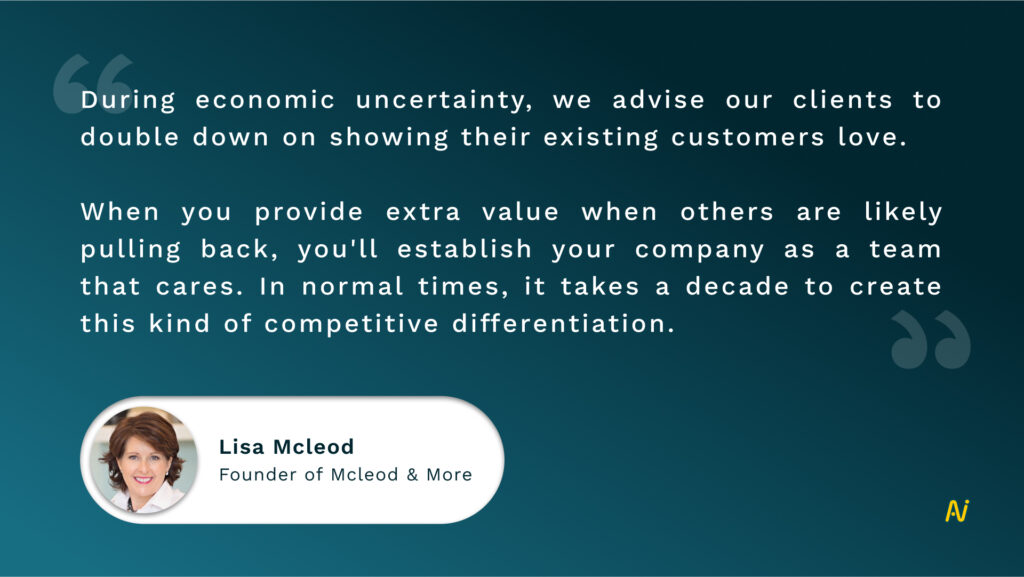
If there’s anything the 2020s have shown us, it’s that businesses need a reliable and resilient approach to growth. You can do that by retaining existing customers while chasing new leads.
So, how can you use one of these models to stop the sales pipeline leaks? By understanding the reasons behind these leaks and using AI to fix them.
Understanding Sales Pipeline Leaks and the Reasons Behind It
A sales pipeline leak is an avoidable loss in revenue. These avoidable losses result from:
- Manual data entry which contains errors (like inaccurate or incomplete contact data)
- Not tracking customer data and updating deal progress information
- Bloating the pipeline with low intent leads, i.e., poor deal prioritization
- Single threading and not engaging with the entire buying committee
- Lack of process discipline by not entering account data on time
- Inaccurate reporting and insights as a result of poor-quality data
- Poor adoption of tools by reps or having too many tools and reps not knowing how to use them
- Ineffective deal reviews with no real-time feedback and buyer meeting analysis
- Disparate data between teams
- Lack of common data language and data governance framework
- Entering non-compliant data and impacting data security adversely
Dirty data is the most significant culprit for sales pipeline leaks. It creates data silos and a poor flow of information between tools. This messes up the alignment between revenue teams (marketing, sales, and customer success).
Inaccurate, incomplete, and non-compliant data ultimately build unreliable insights.
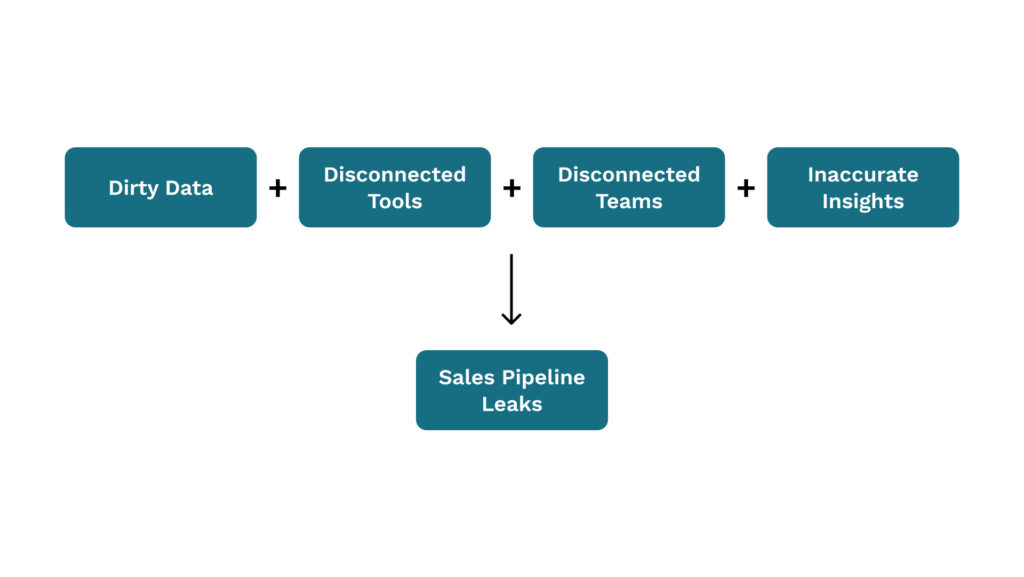
Sales pipeline leaks eventually lead to an unhappy buying experience and accelerated churn.
How AI Can Effectively Plug Sales Pipeline Leaks
A growing number of business transactions breeds growing volumes of customer data. Plus, sales deals are more complex today. A buyer is no longer an individual but a whole committee of stakeholders.
Having massive customer data becomes an opportunity to glean deeper insights. Sales organizations could gather insights not just on the champion but all the other committee members, too.
However, extracting these insights and making them actionable is challenging, given the sheer scale of data. It also gets increasingly hard to identify sales pipeline leaks.
This is where artificial intelligence (AI) becomes table stakes to craft stellar customer experiences. It learns from your business’s data to make the revenue process more efficient.
Here’s a snapshot of how AI conducts sales pipeline analysis to plug leaks effectively:
- AI can scour massive chunks of data
- It spots patterns and dissects trends
- It can generate actionable insights
- AI automates repetitive tasks (like creating meeting reminders)
- It reduces manual dependency and interference
- AI has capabilities to detect security threats in real-time
- It increases rep productivity and selling efficiency by optimizing resources
- It can also adapt to your company’s unique workflows
Combining AI’s power with the CRM and clean data lets you detect sales pipeline leaks and plug them.
Leveraging AI To Address and Prevent Sales Pipeline Leaks
The global benchmark for acceptable customer churn is 5%. Yet, 30% of organizations have an unacceptably higher churn rate.
What is the best way to fix and prevent leaks? Embed customer retention as a goal, right from the first touch to renewal.
Let’s find out how AI can plug sales pipeline leaks at every stage of the revenue process.
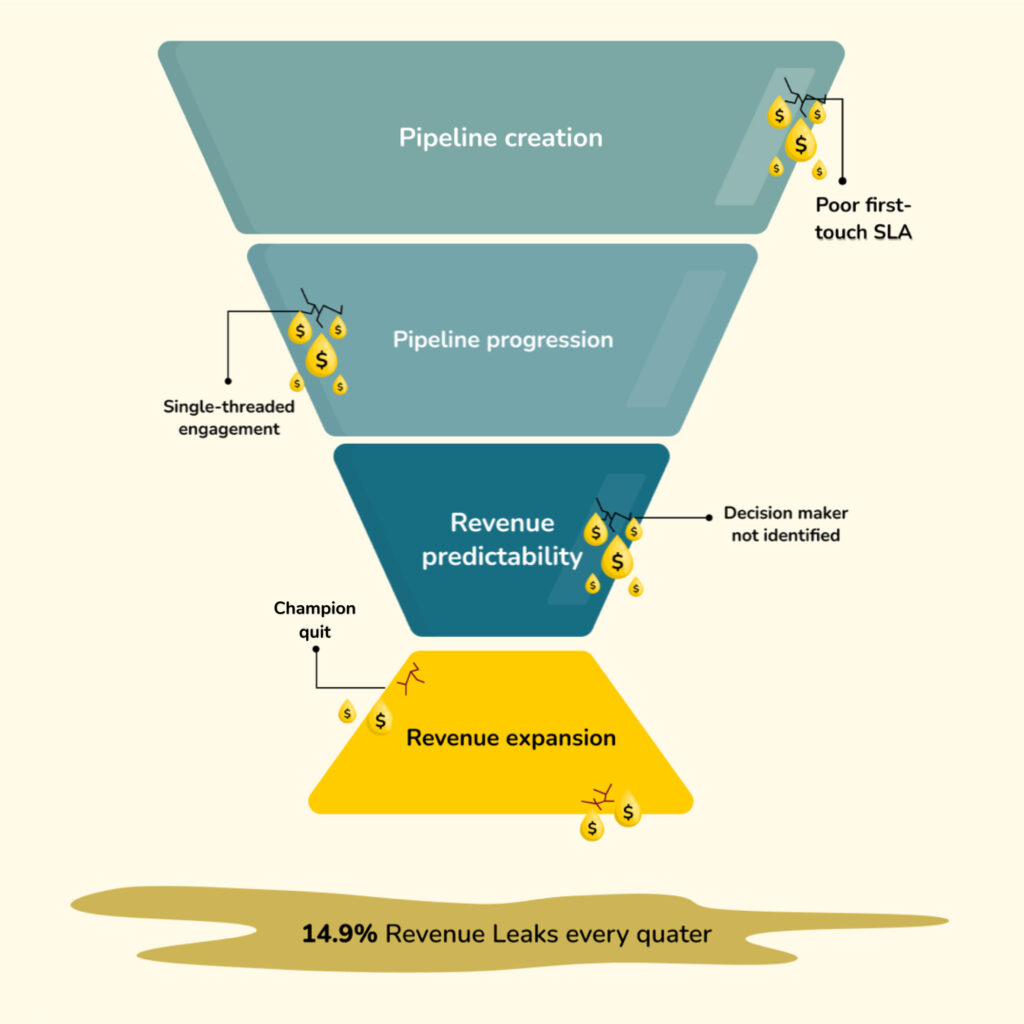
Phase 1: Pipeline creation
Sales pipeline leaks:
- Poor first-touch service level agreement (SLA)
- Failure to get high intent leads to closed-won status
How AI can fix leaks in pipeline creation:
AI will primarily focus on lead qualification and nurturing for marketing and sales at this stage.
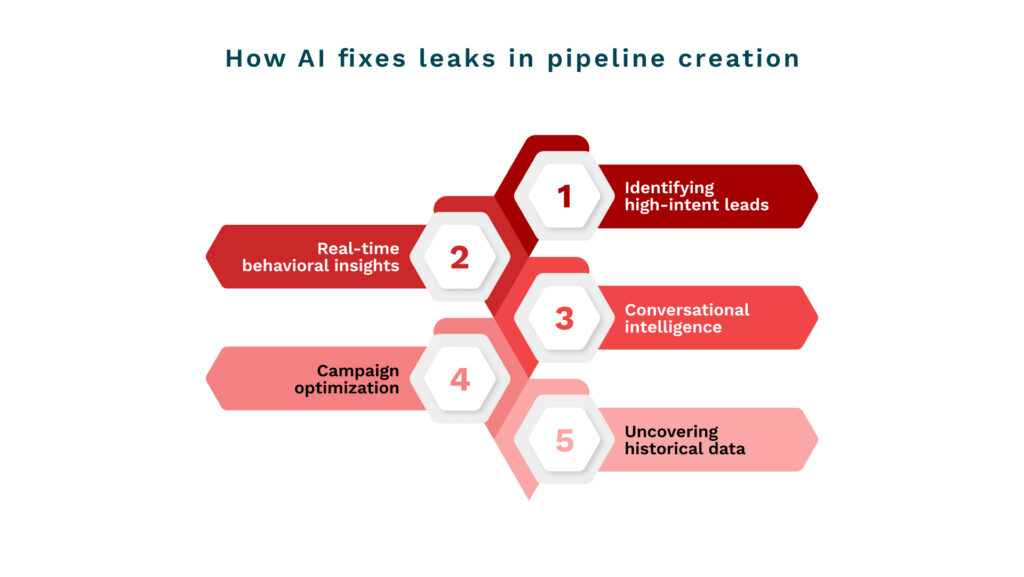
1. Identifying high-intent leads
AI tools conduct sales pipeline analysis to identify high-intent leads. It uses historical data relevant to your business, leads, and the industry. As a result, AI leverages exponentially more signals than traditional methods to qualify leads.
Some factors AI considers to assign lead scores:
- Demographics
- Firmographics
- Website interactions
- Email engagement
- Social media engagement, and more.
2. Real-time behavioral insights
AI uses buyer intent data for lead nurturing. Use it to establish clear lead qualification criteria. You can gauge a prospect’s engagement levels with you and determine who is more likely to convert.
Also, you can gather buyer feedback, pass it on to sales, and incorporate critical points into the pitch. AI translates buyer conversations into actionable insights for future sales and account visibility.
3. Conversational intelligence
Buyers use ten or more channels to reach sellers, dispersing information on multiple platforms. AI can analyze conversations across all channels using conversational intelligence.
Moreover, you can integrate ChatGPT into your chatbots, customizing the conversation pathways.
Conversational AI decreases response time and keeps leads engaged.
4. Campaign optimization
AI optimizes campaigns by determining which ones work for a specific audience segment. It automatically allocates more resources to those and adjusts the content, CTAs, and ad budgets in real-time.
5. Uncovering historical data
AI discovers historical data on lost contacts and engagements. Reps can revive lost deals and re-engage with these leads. It helps you figure:
- Steps missed by sales teams miss in the buyer journey
- Missing contacts from multiple channels
- Deal progress and how it changed over time
Phase 2: Pipeline progression
Sales pipeline leaks:
- Single-threaded engagement with the buyer
- Poor deal prioritization
How AI can fix leaks in pipeline progression:
In phase 2 of the sales pipeline, focus AI’s efforts on prospecting, evaluation, and continued engagement to deal closure.

1. Actionable insights
AI provides granular, actionable insights on deals and contacts. It shows:
- Number of leads added to the pipeline
- Lead sources
- Number of touches with each lead
- Leads moving forward to conversion
- High-value deals
2. Engagement alerts
AI generates engagement alerts for when deals start to stagnate. Reps can spring into action, re-engage with these leads, and stop them from becoming inactive.
This feature is specifically helpful for lower quota attainment. Only 57% of salespersons met their annual quotas in 2019, compared to 63% in 2012.
3. Improved coaching
AI helps sales leaders and managers to coach reps on the next best action. They provide recommendations on:
- How to approach buyers
- How to re-engage with inactive leads
- What resources reps can provide to convert stagnating deals
AI provides contextual information on prospects so reps can personalize their approach. 89% of buyers will consider purchasing from a brand if the seller can change their thought process.
Managers can quickly assign the deal to another rep if that doesn’t work.
4. Process adherence
AI provides call monitoring, real-time deal insights, and information-sharing to drive process adherence.
Using conversation and deal insights, you can replicate winning behaviors. This improved performance supports agile improvement and increased efficiency.
5. Better multithreading
AI offers multithreading and account relationship insights. It can enrich contact data so reps can undertake account-based selling.
Even as the deal becomes more complex and intricate, reps can use AI to seamlessly:
- Access the buyer committee map
- Determine the best-selling approach for each account
- Identify the right stakeholders
- Orchestrate tailored conversations with multiple stakeholders
- Prioritize gaps for the buyer
- Offer personalized solutions for each gap and stakeholder
Phase 3: Revenue predictability
Sales pipeline leaks:
- Sales hasn’t identified the decision-maker
- No access to power
How AI can fix leaks in revenue predictability:
42% of sales teams use the CRM for storing information about leads and customers. But storing information isn’t enough. You could use that data to grow revenue and plug sales pipeline leaks.
And so, in revenue predictability, AI becomes a part of the strategy to use data in the CRM to:
- Build proposals
- Win more deals
- Conduct frictionless handoffs from sales to customer success
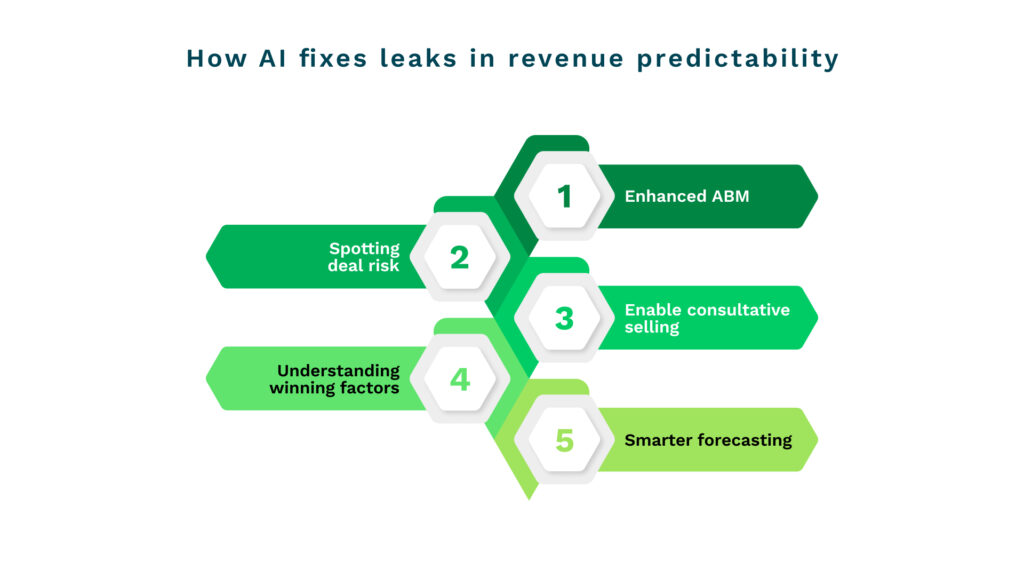
1. Enhanced ABM
AI enhances account-based marketing (ABM) with custom audience lists for each named account. It captures complete contact data, details on buyer roles (in the buyer group), and meeting details. Using sales pipeline analysis and contextual mapping, you can identify key decision-makers.
Reps use enriched contacts and buyer group intelligence to achieve comprehensive account coverage.
2. Spotting deal risks
Buyers can evaluate multiple solutions at a time. It increases deal risk as buyers move between several sellers at a time. AI spots these sales pipeline leaks before they impact your revenue by analyzing historical data.
You can take proactive measures to retain customers at risk. Plus, reps can double down on winning deals due to close soon.
3. Enable consultative selling
AI-based tools empower reps to share relevant use cases. It generates analyses from insights on the customer’s:
- Competitors
- Financial performance
- Key performance indicators (KPIs)
You can tailor these use cases to the customer’s and seller’s capabilities.
4. Understanding winning factors
AI detects patterns across buyer segments, territories, and industry verticals to gather winning deal factors. It measures activities and buyer committee coverage, so you can set benchmarks to optimize sales cycles.
Your reps can replicate these factors to drive efficiency at scale.
5. Smarter forecasting
Make forecasting tools work smarter and more efficiently with AI. You can predict performance at the individual rep as well as enterprise level. You can also account for deals no longer at the “commit” stage and adjust them in the next quarter’s targets.
AI-based forecasting tools analyze multiple contributing factors, including:
- Deal portfolio
- Revenue figures
- Demographics
- Product or product line
- Business model
- Sales intelligence
- Deal health monitoring, and more.
This comprehensive set of factors helps build better forecasts by:
- Predicting short and long-term performance
- Improving prediction accuracy
- Assisting leaders to make more informed decisions
Phase 4: Revenue expansion
Sales pipeline leaks:
- Champion quits
- Lack of clean data on customers during the sales and post-sales process
How AI can fix leaks in revenue expansion:
AI facilitates customer success activities in the revenue expansion stage (after the deal is won).
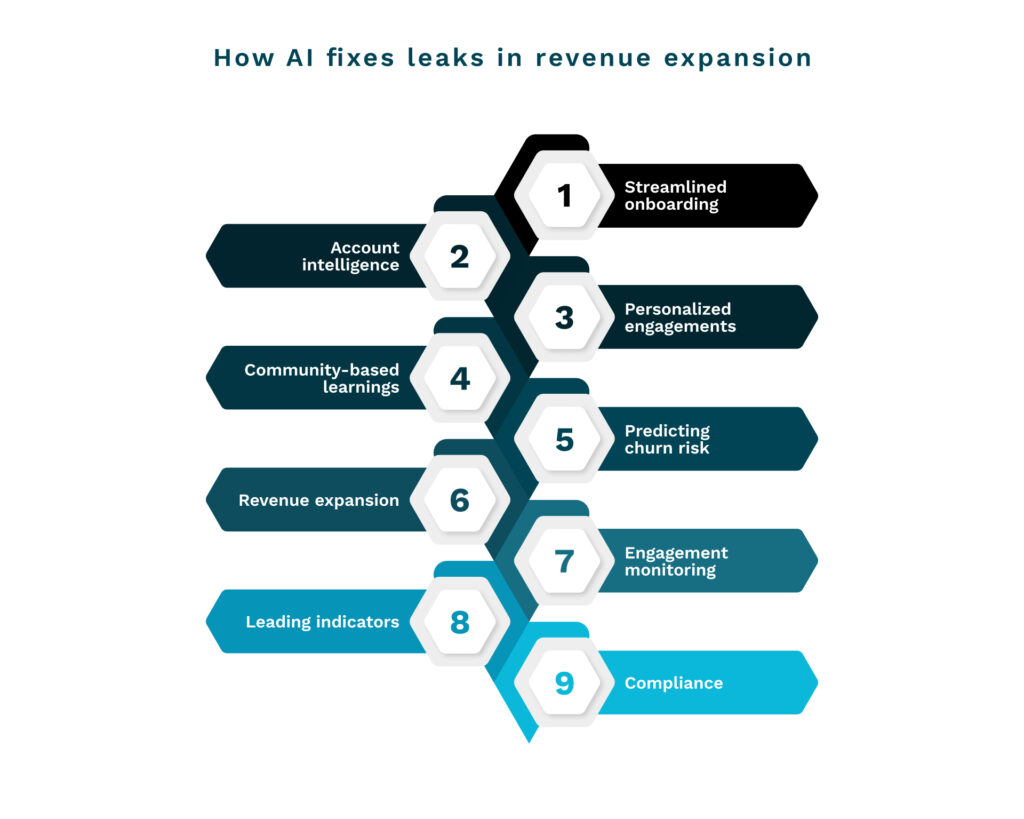
1. Streamlined onboarding
AI helps customer success reps by:
- Automating onboarding tasks
- Sending customers personalized messages
- Guiding customers through the initial setup
- Automatically capturing post-sales activities
- Adding the data to the account, including new contacts, emails and meetings
2. Account intelligence
Over 81% of sellers have lost or stalled deals in the past 12 months. It happens particularly when a critical stakeholder leaves the client’s or prospect’s company. AI solves this problem by giving customer success a 360-degree view of the buying committee.
Reps can identify champions and check engagement levels with them. It’s advantageous when the champion quits, and you may need to find an alternative.
3. Personalized engagements
AI tools use previous buyer data to figure ongoing unique requirements. Automated support and ticketing can also handle several repetitive activities. It allows your team to focus on more pressing matters.
These repetitive tasks could include:
- Responding to routine queries
- Reducing response time
- Redirecting complex issues to customer success reps
Gradually, your customer success team can become a trusted partner. It can help with executing and formulating strategies for the buyer.
4. Community-based learnings
You can dig out granular insights on:
- How do customers use your solution?
- What are their preferred features?
- How does your product solve its intended use cases?
- What are their usage patterns?
These insights come from community-based learnings where one buyer shares their feedback with you. Use this feedback to help other customers in similar industries level up.
AI orchestrates better use cases for customers unaware of them.
5. Predicting churn risk
Predictive analytics, sentiment analysis, and sales pipeline analysis can anticipate churn risk. AI predicts the risk by looking at buyer transactions, engagements, feedback, and social media activity.
Reps can reduce churn through proactive measures to retain customers. For instance, they can identify single-threaded accounts and increase engagement with multiple stakeholders.
Customer service teams receive automated alerts via:
- Emails
- Platform or tool dashboards
- Virtual messaging apps (like Slack or Microsoft Teams)
These alerts show reps which deals are up for renewal or need specific attention.
6. Revenue expansion
AI finds upsell and cross-sell opportunities based on a buyer’s behavioral insights. It then suggests relevant solutions and features to sell to existing customers.
7. Engagement monitoring
AI can monitor executive engagement in Quarterly Business Reviews (QBRs). It ensures you follow the cadence and key stakeholders are present. Similarly, it monitors rep involvement in QBRs and account activations. This feature removes blindspots so that reps and leaders are aligned.
8. Leading indicators
Managers can coach customer success reps using the right leading indicators. With better coaching, they can:
- Anticipate customer needs
- Offer recommendations and solutions
9. Compliance
AI facilitates your data governance process and discovers privacy vulnerabilities. You can responsibly process, manage, and store data by following legal regulations.
Customers don’t have to worry about businesses using their data for wrong and unethical purposes. Subsequently, compliance establishes trust and improves customer loyalty.

Plug Sales Pipeline Leaks From Lead to Retention With AI
Nektar’s AI platform powers your pipeline for a frictionless customer experience, from lead to retention and expansion.
Nektar drives funnel efficiency by plugging gaps that might exist in your CRM data, which in turn helps discover hidden revenue from your customer interaction data.
Our capabilities facilitate the lead-to-retention journey across the revenue funnel by:
- Unifying data capture
- Offering full funnel visibility with revenue intelligence
- Helping identify champions early in the process
- Helping with consistent engagement with the buyer group throughout the buyer journey
- Monitoring rep productivity
- Preventing churn risk with relationship intelligence
- Automated CRM data capture and sync
Take control of your sales pipeline and revenue funnel today.
Get in touch to see Nektar in action.
PUBLISHED BY
